A Vintage Amp Surprise: 1966 Gibson GA-45RVT Saturn Amp
I do a good bit of poking about on the Internet, investigating music history as well as old and new gear. Interesting things come to light all the time, often from unexpected places. The majority of my searching is done while I'm just looking for information, window-shopping the world of knowledge that's floating around. For instance, my most recent quest was started by a search based on unabashed nostalgia. You see, when I was in college bands in the 1970s, I played through an old Gibson GA-55RVT Ranger guitar amplifier. The Ranger was often referred to as the “Kalamazoo Super” because of its 4x10" speaker configuration and fifty watts, though it was quite a different beastie from the Fender Super Reverb that lent the moniker. My lead guitar sound drew lots of compliments when I was using that amp. Eventually, master volume amps became all the rage and I traded the Ranger for another amp. But recently in a fit of idle curiosity and nostalgia, I ran an Internet search, "Gibson GA-55RVT," hoping to see if any were still floating around. They were, but for some reason my search also brought up an example of the little brother of the Ranger, the GA-45RVT Saturn, that was for sale at a local used gear dealer. What the heck? I'd never seen a Saturn. Oh, boy. Now my interest was piqued.
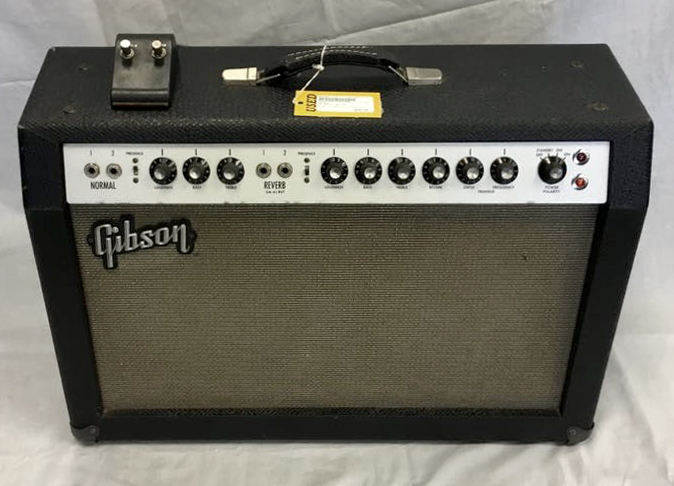 The Store Picture
The Store Picture
A LITTLE BACKGROUND ON THIS ERA OF GIBSON AMPLIFIERS:
Both of these amps were from the “missile and satellite” or “whiteface” era of Gibson, 1965 through 1967. It was, after all, the Space Age and we were all going to be astronauts, right? I know I was. The Gibson amps offered during that era featured raw aluminum faceplates (hence the “whiteface” designation) and were named for U.S. missiles and satellites: Vanguard, Apollo, Ranger, Saturn, Lancer, Minuteman, Explorer, and one oddball, the Skylark, whose name was carried over from an earlier period. I'm guessing most people can remember the Saturn I and Saturn V boosters of the Apollo Program? There you go. Like Fender, in this period Gibson began changing their amp designs to yield more clean power to support the surf music fad. As a result, just as in the “Silverface” period for Fender, the whiteface Gibson period has developed a lesser reputation from their earlier periods, a reputation that they have some sort of “tone suck” circuit and that people often have to tinker with them to make them sound decent. I can hear lips curling all over the Internet right now. My Ranger had a sort of dark sound but it had a wonderful smooth distortion that everyone loved back then and it compressed and sustained nicely when it was pushed, yeilding a sound like some of the Allman Brothers' later, Eat a Peach studio sounds. All I had to do was put a clean boost out front to get a great lead sound. Of course, it was LOUD and insufferable heavy at around seventy pounds. The GA-45RVT has the same sixty-watt power amp and a very similar preamp to that of the Ranger. When I had my Ranger back then, the Gibson whiteface amps didn't have a negative reputation, so I thought I was "in the tall corn." Doing research, I read some Internet complaints that the GA-45RVT is a quiet amp. Hmmmm... "That," I thought, "might just be a plus." Because this amp is so similar to mine, perhaps it could reproduce my old experience at a lower volume and weight... Hah!
“VISITING” THIS EXAMPLE:
 I'm not the type who typically makes snap decisions. I usually have to think a while before I consider a purchase. In this case I "visited" the amp repeatedly in the store over a couple of weeks, playing it for a decent amount of time on each visit. Each visit I pushed it up to the end of the volume dial and enjoyed hearing it buzz all the snares in the room sympathetically. I bet that made me popular. I went on the store's Facebook site and figured out that the amp had been in the store for at least a couple of months. Not exactly flying off the shelf, eh? In fact as I watched, store management took a markdown. On another visit I dug around inside the cabinet and found that it was all-original and complete, including the speakers, trannies, footswitch, all the tube shields, and even the Gibson logo. That nice-looking Gibson logo out front is the very first thing to be broken when these amps are abused. Unmolested, original examples of the logo fetch astronomical prices on eBay - so much so that forgers are selling copies there. The pots and switches on this amp were clean and smooth throughout their travels and the amp was definitely quieter than its larger brother. The sound was strong, there was little noise, and there were no rattles or fizzes even when I pushed it to the top of the dial. Now, it was a little dirty, but I could see a gem under the grime. There were a few dings on the control panel and a small hole or two in the grille cloth but that is par for the course on a fifty-year-old amp, isn’t it? That's mojo, baby.
I'm not the type who typically makes snap decisions. I usually have to think a while before I consider a purchase. In this case I "visited" the amp repeatedly in the store over a couple of weeks, playing it for a decent amount of time on each visit. Each visit I pushed it up to the end of the volume dial and enjoyed hearing it buzz all the snares in the room sympathetically. I bet that made me popular. I went on the store's Facebook site and figured out that the amp had been in the store for at least a couple of months. Not exactly flying off the shelf, eh? In fact as I watched, store management took a markdown. On another visit I dug around inside the cabinet and found that it was all-original and complete, including the speakers, trannies, footswitch, all the tube shields, and even the Gibson logo. That nice-looking Gibson logo out front is the very first thing to be broken when these amps are abused. Unmolested, original examples of the logo fetch astronomical prices on eBay - so much so that forgers are selling copies there. The pots and switches on this amp were clean and smooth throughout their travels and the amp was definitely quieter than its larger brother. The sound was strong, there was little noise, and there were no rattles or fizzes even when I pushed it to the top of the dial. Now, it was a little dirty, but I could see a gem under the grime. There were a few dings on the control panel and a small hole or two in the grille cloth but that is par for the course on a fifty-year-old amp, isn’t it? That's mojo, baby.
I stewed on the decision long enough to make my choice and then headed into the store to negotiate. After some polite wheeling and dealing during which I offered another amp as trade fodder, I ended up with a comfortable deal on the amp and took it home. Field day! I immediately spent some time cleaning it up with car interior wipes and a toothbrush. I touched up worn spots in the Tolex with a Sharpie. Why on earth doesn’t everyone clean up vintage amps? It immediately makes them look so much more loved. I also removed the rings of grunge (and fifty years of other people’s DNA) from behind the knobs by gently prying each one off its shaft and wiping. I discovered one odd pot with a split nylon shaft while the rest had split metal shafts with splines. I seem to remember that particular oddity from my old Ranger as well. My wife came home, took one look, and declared, “Hmmm… Looks pretty good for a fifty year old amp.” Success!!!

UNDER THE HOOD:
These old amps can often be time capsules, giving you a glimpse into both the manufacturers and musical business of the time, so I dug in to see what I could find. The amp still has its original transformers and “Gibson Ultrasonic Speakers” with their Original Gold and red Gibson brand stickers applied to the alnico magnets, proudly trumpeting, “Made Expressly for Gibson, Inc.” The stickers mostly cover the ink-stamped date codes on the speaker magnets but I was able to read the manufacturer’s code (137) that verified that they were made by CTS. Best I can tell the tubes are from the period, including the RCA 6L6GC power tubes. Pulling the codes from the original transformers (1965 and 1966) dated this amp to 1966, the peak year for this model’s production. All told, 2524 of these amps were built from 1965 to 1967 with 1364 of them being built in 1966. The original sale was made by Walker Music, Inc., of Milwaukee, WS. Back then, reputable dealers thoughtfully placed a sticker inside to verify their sale. On the back of the chassis there is a legend silkscreened on the chassis, “Gibson Electronics, Division of Gibson, Inc., Kalamazoo, Michigan,” with a cute little atomic logo. Oh, and just in case you never get around to the back, Gibson handily printed the model number on the front under the input jacks on the Reverb channel as well, so you'll never get lost. "GA" indicates "Gibson Amp." "RVT" indicates "reverb and tremolo." There’s an interesting discrepancy between the serial number stamped on the chassis (A04XXXX) and the starting serial written on the published circuit diagram for the Saturn ("A-40XXX to ____ "). Clearly, someone didn’t get the memo.
TECHNICAL:
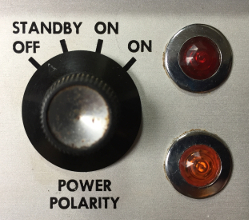 The amp features four 6EU7 dual-triode preamp tubes. Three of them are shared between the channels and the fourth is involved in reverb send and recovery. The 6EU7 was designed to be a high-quality, low-noise replacement for the 12AX7 with an added humbucking capability, but it never caught on. The amp has one 6CG7/6FQ7 driver that is used as the phase inverter. It has one OA2 voltage regulator, a dual-6L6GC push-pull power section that I think in this application provides 35 watts, a 12AU7 for effects send and recovery, a long-tank spring reverb with transformer feed, and an opto-isolator tremolo. The two channels are voiced slightly differently, with two inputs offered for each channel. This amp was built in the 1960s so there’s no headphone out, effects loop, or master volume. It’s straightforward, dumber than dirt, strictly “plug ‘n play.”
The amp features four 6EU7 dual-triode preamp tubes. Three of them are shared between the channels and the fourth is involved in reverb send and recovery. The 6EU7 was designed to be a high-quality, low-noise replacement for the 12AX7 with an added humbucking capability, but it never caught on. The amp has one 6CG7/6FQ7 driver that is used as the phase inverter. It has one OA2 voltage regulator, a dual-6L6GC push-pull power section that I think in this application provides 35 watts, a 12AU7 for effects send and recovery, a long-tank spring reverb with transformer feed, and an opto-isolator tremolo. The two channels are voiced slightly differently, with two inputs offered for each channel. This amp was built in the 1960s so there’s no headphone out, effects loop, or master volume. It’s straightforward, dumber than dirt, strictly “plug ‘n play.”
The whiteface Gibsons have some unique and/or strange features. For instance, the Ranger and Saturn share an interesting four-position rotary power switch that also inverts the ground polarity of the two-prong cord. Yes, this one still has its original two-prong plug. I'm not sure what I'm going to do about that yet. I worked years with ground polarity switches and haven't had a big problem yet. Clockwise from left the switch positions are OFF, STANDBY, ON, and ON (with line polarity inverted). It also features two pilot lights. The lower, amber lamp lights up when the amp is switched onto standby. When you select either of the "ON" positions the amp switches to the upper, red light. Looking at the circuit diagram I was interested to see that the pilot lamps feature neon(!) bulbs, perhaps explaining the fact that they both still work. Space age, indeed. The amp features both a power section filter choke and a reverb send transformer. I’ve not seen a reverb send transformer before. Oh, and hilariously there is a small hole punched in the chassis that allows a length of cloth-covered wire to exit the chassis and run externally to the reverb transformer, as if it were an afterthought. It looks like a funny Gibson bodge added while the amp was in production. Things come in twos on this amp: pilots lights, inputs, channels, speakers, and fuses. Fuses? Yep. There is a mains "Convenience Outlet" on the back that has its own fuse sitting right next to the amp's fuse. The outlet is tilted diagonally so that no wall wart could possibly fit but you can use an extension cord.
The cabinet is thick composite so it is fairly heavy. The hardware is quite solid. The handle is probably the strongest I've encountered, built up from some sort of padding material wound around a steel core and covered with Tolex. The cabinet's Tolex itself is a heavy duty black material, textured with a basketweave design. Inside the back on the right there is a handy “shoe” to neatly receive the two-button footswitch when you aren’t using it. Schmart. The long reverb tank occupies most of the bottom of the cab and lives in the obligatory black bag.
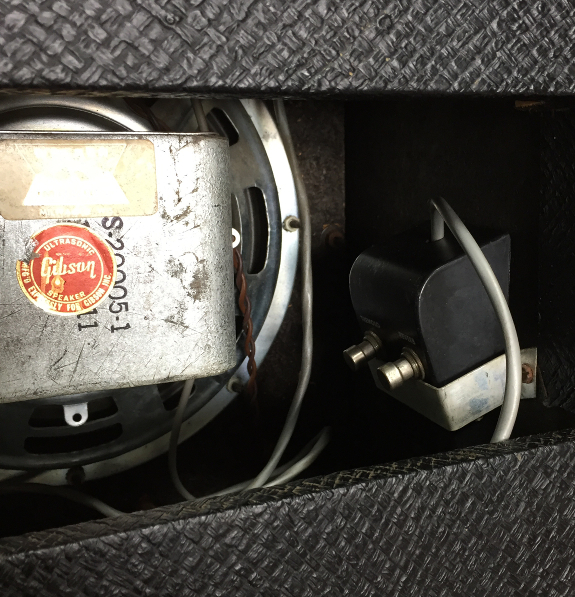
The channel connections and controls are:
"Normal" Channel: Input (x2) Presence Switch, Loudness, Bass, Treble
"Reverb" Channel: Input (x2) Presence Switch, Loudness, Bass, Treble, Reverb, Tremolo Depth and Frequency
PLAYING IT - THE SOUND:
 This is not a Fender amp. Let's get started right there. This is a low-gain amp, and I really mean low gain. The volume controls are really smooth from bottom to top, but unlike a Fender, this amp starts very quietly on the left side of the dial and only begins to open up between six and seven. But even there it is pretty clean. I compared it to a Deluxe Reverb with the two side-by-side. At full volume the Saturn is about as loud as the Deluxe Reverb set on four. Interesting, huh? Definitely not overwelmingly loud for a 6L6 amp. The midrange bulge of the Fender is also quite apparent as you go back and forth. Playing the Saturn with a Les Paul, the distortion sneaks in gently as you pass about seven on the dial. You'll really begin to know you've entered distortion on the top side of nine. Because of the smoothness of the onset of distortion, I'm wondering if the power amp is a low-negative feedback design? Also of note: you simply can't get the amp to distort any more than a bare jangle with a Tele. It stays quite clean right on up to the top. With the Brightness switched off the sound goes thunk, thunk, thunk, an unusably dark sound with a low-pass beginning in the midrange. With the Brightness on and tone controls at five, a humbucker guitar sounds like a surf guitar with guts! We are talking chime city, with a generous midrange carve-out and high-end hair that are reminiscent of a Vox. I’d bet this would be a great amp for a 12-string electric! There isn’t a midrange control knob on either channel like there was on the Ranger. Looking at the circuit diagram HERE and comparing it to that of the Ranger it looks like there is instead a hidden, fixed mid setting that provides that carve-out. I wonder if that is what limits the gain? As I recall, the Ranger’s overall gain was affected by the level of its mid control. The bass response is so strong that the amplifier needs to be elevated off the floor to break the bass coupling or you'll have to run the bass control on zero. The treble is quite bright. With a '74 Les Paul I find myself backing off the highs to around three or four in clean settings.
This is not a Fender amp. Let's get started right there. This is a low-gain amp, and I really mean low gain. The volume controls are really smooth from bottom to top, but unlike a Fender, this amp starts very quietly on the left side of the dial and only begins to open up between six and seven. But even there it is pretty clean. I compared it to a Deluxe Reverb with the two side-by-side. At full volume the Saturn is about as loud as the Deluxe Reverb set on four. Interesting, huh? Definitely not overwelmingly loud for a 6L6 amp. The midrange bulge of the Fender is also quite apparent as you go back and forth. Playing the Saturn with a Les Paul, the distortion sneaks in gently as you pass about seven on the dial. You'll really begin to know you've entered distortion on the top side of nine. Because of the smoothness of the onset of distortion, I'm wondering if the power amp is a low-negative feedback design? Also of note: you simply can't get the amp to distort any more than a bare jangle with a Tele. It stays quite clean right on up to the top. With the Brightness switched off the sound goes thunk, thunk, thunk, an unusably dark sound with a low-pass beginning in the midrange. With the Brightness on and tone controls at five, a humbucker guitar sounds like a surf guitar with guts! We are talking chime city, with a generous midrange carve-out and high-end hair that are reminiscent of a Vox. I’d bet this would be a great amp for a 12-string electric! There isn’t a midrange control knob on either channel like there was on the Ranger. Looking at the circuit diagram HERE and comparing it to that of the Ranger it looks like there is instead a hidden, fixed mid setting that provides that carve-out. I wonder if that is what limits the gain? As I recall, the Ranger’s overall gain was affected by the level of its mid control. The bass response is so strong that the amplifier needs to be elevated off the floor to break the bass coupling or you'll have to run the bass control on zero. The treble is quite bright. With a '74 Les Paul I find myself backing off the highs to around three or four in clean settings.
The amplifier is capable of a really nice, gentle ’70 crunch and jangle with humbuckers but seems to get a little "blatty" when you push it beyond that. I tried a parade of pedals out front of the amp to see if I could both tame the blatt and push the gain. What brought out the best was a Barber Tone Press compressor with a reasonable amount of compression and a touch of gain added. Without the compressor, when you hit distortion and lean in there is still enough dynamic range left in the amp for the high-end to simply rip your head right off. With the compressor engaged you are headed towards the beginning of singing sustain but the sound is quite clean and pretty. Back in the '70s I wrote a couple of songs for that sound so and it's good to have it back. Both channels take a Muff Fuzz well. I suppose by virtue of its transformer send, the reverb is extremely smooth with some high-end roll-off. It sits in the background very nicely without intruding until you get up to four and a half or so and then it gets properly surfy. The tremolo is really gentle and the modulation wave shape is rounded, as you'd expect from an opto-isolator trem. When you approach max vibrato depth the overall gain of the amp drops, which is also what you’d expect from an opto-isolator trem. The pic above is a frame grab from a video of an employee playing the amplifier in the store that can be seen on Facebook, HERE.
THE EXPERIENCE - MEMORY MAGIC:
Old classic amps all put out a warm fragrance when they warm up and run, as I discussed HERE, and this one is no exception. Because the centers of smell and memory management are adjacent in the brain, it sometimes seems as if their responsibilities get co-mingled. As a result, the sense of smell is often able to trigger memories and emotions that are associated with particular smells. This happened rather vividly when this amplifier warmed up during my first long session with it at home and I found myself surrounded by a familiar fragrance that I hadn’t experienced since I owned my Ranger, forty years ago. I was really quite surprised to find that brands of amps seem to share a particular bouquet. The particular scent the Saturn shared with my Gibson Ranger surrounded me with a visceral flood of musical memories and feelings from that time period.

After Cleanup
FLAWS & QUIRKS (MOST VINTAGE AMPS HAVE THEM):
While I was giving the amp a work-out there was a sudden, loud hum that gave me a little scare. I did a little troubleshooting and discovered that the hum went away when I switched off the reverb at the footswitch. Ah-hah! I re-seated the reverb/trem footswitch plug and the hum went away. Perhaps it was shaken loose in transit. Also, with the reverb dialed all the way down there is some minor reverb bleed onto both channels unless you use the footswitch to turn the reverb off. That tells me that something isn’t quite right- that there is a bleed between the channels somewhere. While examining the back of the amp I discovered that some of the nuts holding on the speakers were visibly loose, as in backed off on the studs until they didn’t even touch the rim of speaker basket. I tightened them with my fingers and got a little nostalgic surprise: if you don’t properly tighten them they’ll resonate and rattle at high volume and it sounds just like an electrical failure. This happened once before with my Ranger. You just need to either cinch them down a little or back them off to end the problem.
THE TAKEAWAY:
So, I've found an interesting amp with lots of sound possibilities and with strong links to the past for me - and I found it in an unexpected place. I'll admit it took me a little more effort to learn to drive this amp than it would with the typical Fender - the inverted volume control gain structure is a bit out of the ordinary and the basic voice that Gibson chose for it is quite different from the typical Fender as well. But in exchange for the investment of time, it really brings humbucker-equipped guitars to life in a bright, sparkly way. It's almost as if Gibson designed this thing to make one of their guitars sound good. Nah! Couldn't be. When evaluating an amp, I always wonder, "Could I live with only this amp at a gig?" I think the answer in this case is "maybe." While the amp offers some very cool sounds, there are other, midrangey ones that are missing. I wouldn't mind pairing it up with a Fender or a Marshall, though. As to the amp's condition, I wouldn't be surprised if it ends up going to the tech for a few fixy tweaks eventually, but for the price of admission this was one great buy. It will be a fun addition to the studio gang, offering that Voxy thing it does well. Sometimes it pays off to ignore popular preconceptions, and your own, when you are out looking at guitar gear.
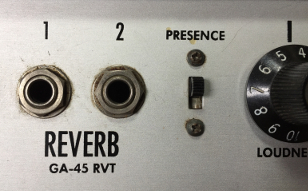
= =
=
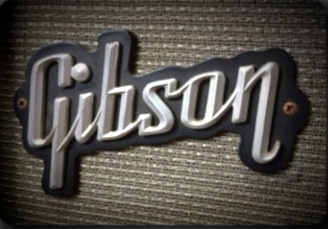


 I'm not the type who typically makes snap decisions. I usually have to think a while before I consider a purchase. In this case I "visited" the amp repeatedly in the store over a couple of weeks, playing it for a decent amount of time on each visit. Each visit I pushed it up to the end of the volume dial and enjoyed hearing it buzz all the snares in the room sympathetically. I bet that made me popular. I went on the store's Facebook site and figured out that the amp had been in the store for at least a couple of months. Not exactly flying off the shelf, eh? In fact as I watched, store management took a markdown. On another visit I dug around inside the cabinet and found that it was all-original and complete, including the speakers, trannies, footswitch, all the tube shields, and even the Gibson logo. That nice-looking Gibson logo out front is the very first thing to be broken when these amps are abused. Unmolested, original examples of the logo fetch astronomical prices on eBay - so much so that forgers are selling copies there. The pots and switches on this amp were clean and smooth throughout their travels and the amp was definitely quieter than its larger brother. The sound was strong, there was little noise, and there were no rattles or fizzes even when I pushed it to the top of the dial. Now, it was a little dirty, but I could see a gem under the grime. There were a few dings on the control panel and a small hole or two in the grille cloth but that is par for the course on a fifty-year-old amp, isn’t it? That's mojo, baby.
I'm not the type who typically makes snap decisions. I usually have to think a while before I consider a purchase. In this case I "visited" the amp repeatedly in the store over a couple of weeks, playing it for a decent amount of time on each visit. Each visit I pushed it up to the end of the volume dial and enjoyed hearing it buzz all the snares in the room sympathetically. I bet that made me popular. I went on the store's Facebook site and figured out that the amp had been in the store for at least a couple of months. Not exactly flying off the shelf, eh? In fact as I watched, store management took a markdown. On another visit I dug around inside the cabinet and found that it was all-original and complete, including the speakers, trannies, footswitch, all the tube shields, and even the Gibson logo. That nice-looking Gibson logo out front is the very first thing to be broken when these amps are abused. Unmolested, original examples of the logo fetch astronomical prices on eBay - so much so that forgers are selling copies there. The pots and switches on this amp were clean and smooth throughout their travels and the amp was definitely quieter than its larger brother. The sound was strong, there was little noise, and there were no rattles or fizzes even when I pushed it to the top of the dial. Now, it was a little dirty, but I could see a gem under the grime. There were a few dings on the control panel and a small hole or two in the grille cloth but that is par for the course on a fifty-year-old amp, isn’t it? That's mojo, baby.
 The amp features four 6EU7 dual-triode preamp tubes. Three of them are shared between the channels and the fourth is involved in reverb send and recovery. The 6EU7 was designed to be a high-quality, low-noise replacement for the 12AX7 with an added humbucking capability, but it never caught on. The amp has one 6CG7/6FQ7 driver that is used as the phase inverter. It has one OA2 voltage regulator, a dual-6L6GC push-pull power section that I think in this application provides 35 watts, a 12AU7 for effects send and recovery, a long-tank spring reverb with transformer feed, and an opto-isolator tremolo. The two channels are voiced slightly differently, with two inputs offered for each channel. This amp was built in the 1960s so there’s no headphone out, effects loop, or master volume. It’s straightforward, dumber than dirt, strictly “plug ‘n play.”
The amp features four 6EU7 dual-triode preamp tubes. Three of them are shared between the channels and the fourth is involved in reverb send and recovery. The 6EU7 was designed to be a high-quality, low-noise replacement for the 12AX7 with an added humbucking capability, but it never caught on. The amp has one 6CG7/6FQ7 driver that is used as the phase inverter. It has one OA2 voltage regulator, a dual-6L6GC push-pull power section that I think in this application provides 35 watts, a 12AU7 for effects send and recovery, a long-tank spring reverb with transformer feed, and an opto-isolator tremolo. The two channels are voiced slightly differently, with two inputs offered for each channel. This amp was built in the 1960s so there’s no headphone out, effects loop, or master volume. It’s straightforward, dumber than dirt, strictly “plug ‘n play.”
 This is not a Fender amp. Let's get started right there. This is a low-gain amp, and I really mean low gain. The volume controls are really smooth from bottom to top, but unlike a Fender, this amp starts very quietly on the left side of the dial and only begins to open up between six and seven. But even there it is pretty clean. I compared it to a Deluxe Reverb with the two side-by-side. At full volume the Saturn is about as loud as the Deluxe Reverb set on four. Interesting, huh? Definitely not overwelmingly loud for a 6L6 amp. The midrange bulge of the Fender is also quite apparent as you go back and forth. Playing the Saturn with a Les Paul, the distortion sneaks in gently as you pass about seven on the dial. You'll really begin to know you've entered distortion on the top side of nine. Because of the smoothness of the onset of distortion, I'm wondering if the power amp is a low-negative feedback design? Also of note: you simply can't get the amp to distort any more than a bare jangle with a Tele. It stays quite clean right on up to the top. With the Brightness switched off the sound goes thunk, thunk, thunk, an unusably dark sound with a low-pass beginning in the midrange. With the Brightness on and tone controls at five, a humbucker guitar sounds like a surf guitar with guts! We are talking chime city, with a generous midrange carve-out and high-end hair that are reminiscent of a Vox. I’d bet this would be a great amp for a 12-string electric! There isn’t a midrange control knob on either channel like there was on the Ranger. Looking at the circuit diagram HERE and comparing it to that of the Ranger it looks like there is instead a hidden, fixed mid setting that provides that carve-out. I wonder if that is what limits the gain? As I recall, the Ranger’s overall gain was affected by the level of its mid control. The bass response is so strong that the amplifier needs to be elevated off the floor to break the bass coupling or you'll have to run the bass control on zero. The treble is quite bright. With a '74 Les Paul I find myself backing off the highs to around three or four in clean settings.
This is not a Fender amp. Let's get started right there. This is a low-gain amp, and I really mean low gain. The volume controls are really smooth from bottom to top, but unlike a Fender, this amp starts very quietly on the left side of the dial and only begins to open up between six and seven. But even there it is pretty clean. I compared it to a Deluxe Reverb with the two side-by-side. At full volume the Saturn is about as loud as the Deluxe Reverb set on four. Interesting, huh? Definitely not overwelmingly loud for a 6L6 amp. The midrange bulge of the Fender is also quite apparent as you go back and forth. Playing the Saturn with a Les Paul, the distortion sneaks in gently as you pass about seven on the dial. You'll really begin to know you've entered distortion on the top side of nine. Because of the smoothness of the onset of distortion, I'm wondering if the power amp is a low-negative feedback design? Also of note: you simply can't get the amp to distort any more than a bare jangle with a Tele. It stays quite clean right on up to the top. With the Brightness switched off the sound goes thunk, thunk, thunk, an unusably dark sound with a low-pass beginning in the midrange. With the Brightness on and tone controls at five, a humbucker guitar sounds like a surf guitar with guts! We are talking chime city, with a generous midrange carve-out and high-end hair that are reminiscent of a Vox. I’d bet this would be a great amp for a 12-string electric! There isn’t a midrange control knob on either channel like there was on the Ranger. Looking at the circuit diagram HERE and comparing it to that of the Ranger it looks like there is instead a hidden, fixed mid setting that provides that carve-out. I wonder if that is what limits the gain? As I recall, the Ranger’s overall gain was affected by the level of its mid control. The bass response is so strong that the amplifier needs to be elevated off the floor to break the bass coupling or you'll have to run the bass control on zero. The treble is quite bright. With a '74 Les Paul I find myself backing off the highs to around three or four in clean settings.
